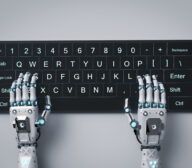Top 11 Predictions for Technology in 2023
Technology is evolving every day, and IT organizations must constantly reinvent or modernize to help their companies remain current. This technology modernization effort is continuous, affecting more than just the IT department.
Prediction 01
Data quality is top of mind
Data quality issues are slowing ability to use Artificial Intelligence (AI) effectively, putting data integrity top of mind.
Companies are seeking ways to validate the quality and integrity of data at its entry point prior to various manipulations, storage, and consumption in Analytics & Reporting, according to SPR Data Director Steven DeVoe and Testing Director Nancy Kastl. IT organizations are under pressure to prove data validity to business leaders and lack the methods/tools to validate millions of rows of data. “Manual ‘stare and compare’ methods leave companies at risk with their data quality and integrity,” says Kastl.
Prediction 02
Adopting no-code AI tools
Corporate America will adopt no-code AI tools, but not necessarily gain more value.
We will see a significant adoption of no-code AI tools on AWS and Azure by corporate America. These tools will allow businesspeople, with little to no statistics or AI background to create simple machine learning (ML) models that provide an exciting, but small, incremental value to the business. “The hype and ease and low cost to jump on this bandwagon will be insatiable,” says Matt Mead, CTO of SPR. “The excitement will build, but ultimately businesses will realize the no-code models are brittle, the majority will be flawed, and therefore ultimately will not provide the value once thought.” A working organizational model will evolve where the business analysts will collaborate with a Data Science team to vet and enhance models generated from no-code tools.
Prediction 03
Rising demand for codeless testing
The shift toward codeless testing is driven by ML and AI.
The demand for codeless testing will rise at 15.5% compound annual growth rate (CAGR) between 2021 and 2031 in comparison to the 10.6% CAGR registered during 2016-2020, according to Future Market Insights Report. The shift toward codeless testing has been widely driven by the advent of machine learning and artificial intelligence. “Rising investments in artificial intelligence technology is estimated to create growth opportunities for codeless testing, as it has the ability to create test cases based on actual user data and to learn from different user flows,” says Kastl. The integration of ML and AI in codeless testing tools is easing usage, which is also set to assist market growth.


Prediction 04
AI, Blockchain, AR + User Experience
The user experience of AI, Blockchain, and Augmented Reality (AR) will become more prominent.
It seems it’s been several years that we’ve been calling AI, Blockchain and AR the technology of the future; but that technology really is the next frontier in UX design and UI design. By combining virtual reality and artificial intelligence, we will move into incredibly social and collaborative worlds between humans and AI. SPR’s User Experience Design Director Taylor Regan says there will be a focus on real use cases in this area that will demystify technological advances.
Prediction 05
Remote workforce + User Experience
The user experience and functionality of internal systems will start to reflect the needs of a fully remote workforce with hybrid schedules.
Organizations have accepted remote work as the new normal but aren’t totally comfortable with it. “We are not yet familiar with the long-term ramifications of this arrangement,” says Justin Rodenbostel, Executive Vice President of Delivery, SPR. “We’re still exploring how user interfaces are designed and what devices they are optimized for, how systems are optimized for hybrid work schedules, and how internal customer satisfaction is prioritized – and how that relates back to retention.”
Prediction 06
Cloud budgets under scrutiny
Organizations will evaluate their cloud investments and look to optimize through modernization.
Cloud customers will feel the pinch in 2023 as the economy slows, thus a need to critically evaluate their cloud investments and the real value and savings they are experiencing. Many customers will realize they are not experiencing significant value from their move to the cloud. “AWS, and likely Microsoft, will be feverishly working with their key cloud customers to maintain or enhance the customer’s engagement level,” says Matt Mead, something he says was reinforced at AWS re:Invent. “We expect more activity to move from monolithic architectures to serverless architectures.”


Prediction 07
Data vital as budgets under scrutiny
A tightening economy means data is even more vital to making decisions - especially when budgets are under scrutiny.
With the economy tightening, there is speculation about where the “bottom” is. “We have spent the last decade valuing growth and speed over profitability,” says Steven DeVoe, Director of Data & Analytics at SPR. “Organizations will want to validate their decisions with much more scrutiny as how they spend their dollars matters more.”
Prediction 08
More attention on security
There will be more formal and ongoing threat modeling and implementation of software bill of materials (SBOM) as part of building software that is resonably secure and can be kept secure over time.
The attention on security comes from the White House, with plans to maintain the government’s focus on software procurement as part of a cybersecurity strategy. National Cyber Director Chris Inglis plans to rely on feedback from members of the software industry who are working on recommendations for “streamlining” sector-specific regulations. This is an echo of efforts already underway from a May 2021 executive order on cybersecurity, which initially suggested a SBOM as a required procurement condition. SBOMs give end users greater visibility into the software components that could enter their networks.
Prediction 09
Software & its carbon footprint
As more organizations make good on commitments to carbon neutrality, we'll see carbon footprint calculations being factored into the cost of software implementation and maintenance.
Companies are investing in carbon neutrality and we have seen a wide variety of initiatives related to making these goals. “We’ve seen a few different ideas related to the purchase and management of carbon credits, and how the cost of carbon neutrality can be distributed through an organization’s business units and customers,” says Justin Rodenbostel. Software companies are developing software packages to help make these calculations. Plus, tools like Carbon Aware SDK help optimize an app’s power consumption by running at the greenest time or in the greenest locations.
Prediction 10
Investing in existing talent
Organizations will start to invest in current employees through training and other retention-improvement initiatives.
The World Economic Forum estimates that half of all employees will need reskilling by 2025 as adoption of technology increases. With more than two-thirds of critical skills listed for job openings up for change, we will see employers looking for different skillsets, such as active learning and resilience more and more. Though upskilling your workforce costs money, it is often less expensive than the aggressive recruitment strategies required when looking outside of your own company, according to the U.S. Chamber of Commerce. Jaimie Francis, Vice President of policy programs at the U.S. Chamber of Commerce, advises teams to demonstrate the business case for upskilling investments is an essential step in building and sustaining buy in from key stakeholders. “Data that shows a positive return on investment — and the costs of not investing in upskilling — can be very powerful,” says Francis.
Prediction 11
UX designers who can code
The push to be "lean" will emphasize the need for UX professionals that can execute across core competencies, plus have the chops in visual design and/or front-end development.
Yes, basic coding knowledge can help improve communication between a UI/UX designer and a software developer. But what happens if you are in a “lean” department and the UX professional now needs to handle technical issues? Some CSS and HTML knowledge can be invaluable. Plus, with digital transformation effectively turning every company into a tech company, this means that everyone – no matter what their role – is expected to work with technology to some extent. The skill of the UX and UI designer is to make technology intuitive and accessible to anyone. As we move further into the era of low-code/no-code platforms, this becomes more important as organizations have the power to create applications on their own.



